How to close the pipes in the toilet: how best to hide and hide the pipeline
It’s hard to disagree with the fact that communications in the bathroom are not the most pleasant sight.No matter how expensive pipes with shut-off valves are, they can only decorate a specific loft-type interior. If you are not one of the adherents of industrial design, then there is a strong desire to hide these networks, right?
We suggest considering several options for how to close the pipes in the toilet, leaving access for regular and emergency maintenance. The article describes in detail the technical nuances and ways to implement interesting ideas. The text is supplemented with useful visual appendices and video tutorials.
The content of the article:
Toilet piping diagrams
The issue of masking pipes concerns both budget housing and luxury apartments. The difference lies in the methods of sealing communications, which are largely determined pipe layout diagram.
If in a 15-meter combined bathroom it is possible to cover all the walls with false panels, then in a 2 m² area every centimeter is important. Often, after renovation, the interior space of the toilet often takes on unimaginable shapes.
In typical housing, everything is simple: in the corner of the room there is a common sewer riser, and centralized water supply pipes are installed parallel to it. Internal communications from pipes of smaller diameter are connected to them. Thus, both the vertical riser and horizontally laid branches need camouflage.

Difficulties arise when, instead of a couple of branches, you have to hide water meters that require regular access, filters, collectors, etc.
Simple boxes are not enough here; you have to attach partitions to the load-bearing walls or build structures that resemble screens.
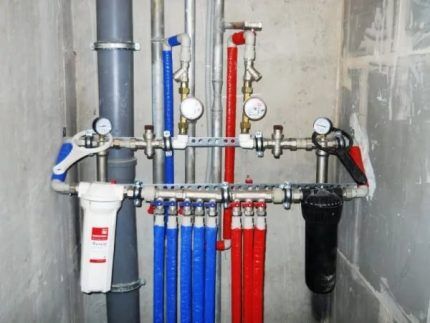
In a private house, everything is simpler if you take care of masking communications even before the project is brought to life. Some pipes can be hidden in the walls, and technical hatches can be created for important components. Filters and metering devices installed in a specially designated room - together with a pump and other equipment responsible for the water supply to the house.
In high-rise buildings, no one will allow the walls to be tapped for pipes, and the characteristics of the walls are not suitable for even partial destruction. What remains is the exterior decor, the options of which we will take a closer look at.
Ways to disguise communications
The choice of method depends on several factors: the size and direction of the pipelines, their location relative to each other, the presence of additional devices, etc.
How to hide sewer and water pipes in a toilet is also influenced by interior design features. For example, blinds do not go well with classics, but they are suitable for minimalism. The choice is up to the homeowners, and a description of how to camouflage pipes is given below.
#1: Box made of plastic panels
Despite some difficulties in constructing structures on a frame, box construction Even beginners take it boldly. Their decision is quite understandable: saving the family budget and the availability of photo and video installation instructions.
What is the difference between plasterboard and plastic boxes? The difference is fundamental: in the first case, you create the basis for further decoration, in the second, you immediately receive a finished product. Therefore, creating boxes from plastic panels is easier, cheaper and faster.
However, this is only possible if the walls in the toilet are also lined with plastic of the same type or, in extreme cases, painted in the color of the panels.
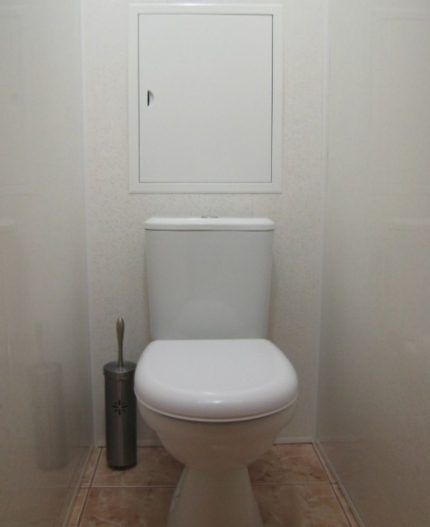
Instructions for installing a plastic box:
- Checking the performance of communications. Necessary in order to provide for pipe repairs, which are usually accompanied by dismantling of structures. The main task is to check connections, components, and operability of devices.
- Treatment of walls and ceilings. Produced with an antiseptic solution to prevent the appearance of black mold and fungus. A closed space with high levels of humidity and insufficient ventilation is a risk zone.
- Creating a sheathing. Performed on all walls or in communication areas. If you need a box to disguise the riser, build a frame. Both wooden slats (bars) and a metal profile designed for drywall are suitable for this.
- Installation of plastic panels. The set of parts happens quickly, the main thing is to fix each one in its place. Small nails are used for fastening. Small gaps at the joints and in the corners can be covered with special decorative strips or liners.
For decoration it is better to purchase a ready-made model plumbing hatch. It is advisable to install a larger model to make it more convenient to service the devices.
If you plan to install a toilet paper holder, at the stage of constructing the frame, you need to attach a mortgage - a wooden block - to the desired place.
#2: Plasterboard construction on a frame
The first stage is preparatory. Materials must be purchased in advance, and the tool for the job must be selected.
To trim a metal profile, you will need metal scissors; to cut wooden parts, you will need a hacksaw or jigsaw. You also need a hammer drill and a screwdriver to fix the parts on the wall with dowels and screws. Wood processing is done with a brush.
Required elements for the construction of the structure:
It is better to treat all wooden blanks (blocks, mortgages, plywood) before starting work so that the protective composition is absorbed and dried. You can cut the parts later, because after erecting the frame, adjustment is often required, and a difference of even 1-2 mm is noticeable.
Next we proceed according to the following scheme:
For any type of further finishing, the drywall must be primed. The same tiles used to decorate the entire toilet are most often used as decorative cladding.
If everything is done carefully, the structure will be durable, and the hatch will be almost invisible. Instead of tiles, plastic panels or painting are sometimes used.
The general rule is relevant: before hiding the pipes in a box in the toilet, you need to check all connections for leaks.
#3: Built-in sanitary cabinet
A plumbing or utility cabinet is a structure on the wall behind the toilet, through the doors of which you can easily access meters, filters, manifold and pipeline.
If there is enough free space, in addition to plumbing fixtures and pipes, behind the doors there can be convenient shelves for cleaning and hygiene products.
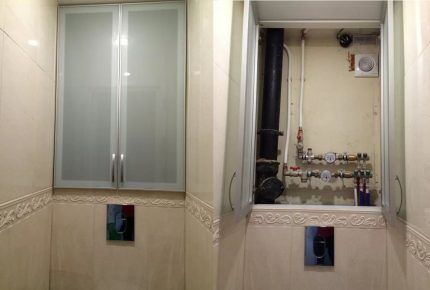
You can choose the material for making doors yourself.
The most popular options:
- wooden slats;
- plywood;
- plastic panels;
- chipboard or MDF boards;
- metal doors;
- glass.
When choosing, focus on the style of the interior as a whole. For example, in a wooden house any models containing wood in one way or another are appropriate, but preferably those made from processed natural wood. In a city toilet lined with plastic, doors made of the same plastic will be less noticeable.
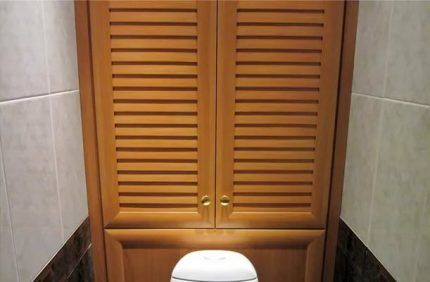
Hinged doors of a sanitary cabinet are mounted according to the same principle as any doors: they are hung from the base frame on hinges.
There are other types of doors: accordions and sliding models that move to the sides. But there is a big difference between them: an accordion does not require additional space, and for a sliding structure, standard separate toilets are simply not suitable due to the lack of free space.
#4: Blinds or roller shutters in decoration
The main advantage of blinds is the preservation of free space in a small room. Unlike doors or a hinged hatch, they do not interfere at all when open. The cost of ordinary plastic blinds is low, but beautifully designed options made of wood or metal are more expensive.
Plastic is a universal material: it is easy to care for and simple to install. But it is not suitable for an elegant interior. Metal models are stronger and have better sound insulation.
It is better not to consider fabric proposals, since textiles are not the most suitable option for a room with high humidity that requires constant cleaning.
In addition to the material of the lamellas, the fittings are also important:
- chains;
- binding threads;
- lifting mechanism.
High-quality parts are a guarantee of long service life of the sanitary screen without repair or replacement.
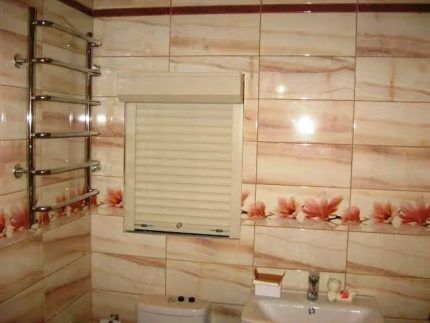
Roller shutters are a more reliable and solid design, but they do not correspond well to the area and interior of typical bathrooms. If the footage allows, then you can install them. Pay attention to automatic models that can be easily opened using the remote control.
Hidden installation - gating
In addition to decorative cladding options for masking pipes, there is also an “internal” option - installing toilet wiring in specially punched grooves. Using a wall chaser, a hammer drill or a door, special grooves are cut out in places where the pipes are laid, where the water supply and sewer lines.
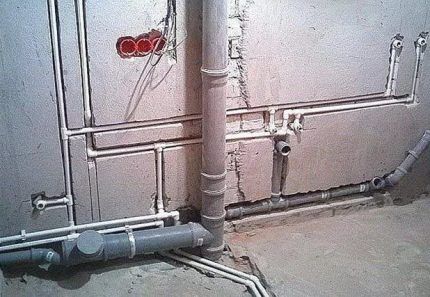
For hidden installations, preference is given to straight pipeline sections with permanent or semi-detachable connections and assemblies. “Invisible” installation has two main advantages: the absence of plumbing parts, the appearance of which does not correspond well to the beautiful wall cladding, and space saving.
There are a number of rules prescribed in regulatory documents that sharply limit the use of gating:
- it is impossible to lay grooves in load-bearing walls;
- For hidden installation, only pipes connected using one-piece, monolithic technology (soldered) are suitable; access to other types is required;
- the gating area must be free from electrical networks;
- when choosing the width of the groove, you need to take into account the linear expansion of the material (for example, polypropylene expands in all directions);
- clamps are used for installation so that the pipes do not make sounds when they come into contact with the walls; sometimes heat-insulating material is used.
Experienced plumbers recommend storing a hidden wiring diagram, as it may be useful during major or emergency repairs. Before sewing up and walling up the pipes in the toilet, we recommend drawing up a detailed drawing.
External placement of communications
Is masking of pipes always required? They are left in sight in the only case: if they are visually attractive and themselves carry some kind of aesthetic meaning. For example, copper pipes, along with plumbing fixtures made of similar material, are often a decorative element.

Installation of an external pipeline, as well as repairs, does not cause difficulties. All parts and connections are visible, so they can be easily replaced or strengthened if necessary. As parts of the decor, they require constant care.
The big disadvantage of metal external pipelines is their high cost. Another inconvenience is the risk of getting burned from a hot pipe.
Conclusions and useful video on the topic
If you have questions about the installation of plumbing ducts or cabinets, it is better to seek recommendations and advice from professionals.
Review of the closet (hatch) in the toilet:
Installation of blinds:
Pipe box - quickly and economically:
To hide water or sewer pipes in the bathroom, consider all factors: the size of the room, the location of the pipeline and riser, the presence of additional devices.
Perhaps the best method of camouflage would be a false wall with doors or a plasterboard box with a hatch - it all depends on the specific conditions.
Share with readers your experience of masking communications in the bathroom. Please leave comments on the article and ask questions that interest you. The feedback form is located below.




Closing the pipes in the toilet is a pressing problem. Especially if the toilet is small and there is not much choice in the location of the pipes. Indeed, the main thing in this process is to close them beautifully, but to ensure easy access to the pipes themselves in the event of an accident. There are a lot of practical tips and options here, especially the technology for installing the box. I think they will be very useful to many.
The box is, of course, a good, very practical idea. But the article says that they are better, i.e. It's easier and cheaper to make from plastic. Its harm has already been proven, since it releases phenols, etc., with prolonged use. I wouldn’t want to have serious health problems because of the toilet or bathroom. Yes, and drywall does not solve this issue for a long time. How can I imagine the situation in our high-rise buildings, where even if you come to an agreement with the upstairs neighbors, someone will flood from the next entrance. But the ideas are great: everything ingenious is simple. Is it possible to invite them themselves to decide on the spot?
Hello. Harm has been proven from PVC, yes. Just like any other plastic. Stretch ceilings are especially not held in high esteem. But there is still a lot of PVC in homes, including wallpaper. And we are generally silent about household chemicals and their harm - air fresheners, perfumes, washing powders, rinse aids... and food in the refrigerator... So, I don’t think that an ordinary screen made of dried plastic will cause big health problems in a bathroom with good ventilation :)